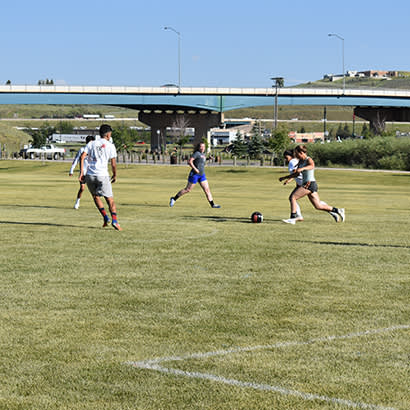
For an enhanced digital experience, read this story in the ezine.
For nearly 10 years, a six-acre grassy field, known as Bear Meadows, has existed in the heart of downtown Evanston, Wyoming. The field — which sits just to the west of the Bear Ice Ponds, next to the Bear River and shares walking trails with a nearby Bear River State Park — is beloved by the community for its large natural area and convenient location. However, a handful of environmental challenges currently hinder the ability to use the land to its full potential. Park and recreation professionals at Evanston Parks and Recreation District (EPRD) are working to transform the underutilized space into a year-round outdoor recreational area for their community.
Site Challenges
In December 2020, EPRD staff met with representatives from NRPA and Sasaki, a leading global design firm, to discuss the environmental challenges of the site and potential land management solutions. During the summer season, the biggest site challenge is the ability to effectively irrigate the land due to soil conditions, reduced annual precipitation and extended drought. “The drainage is probably our biggest issue,” says Kevin Munoz, parks maintenance worker for EPRD. “The main thing is that [the field] sits out in the open all day long, constantly in the sun, so it dries out if you don’t get enough water on it. But at other times, you can drown it and it won’t drain either.”
During winter, another environmental challenge has arisen over recent years due to increasingly extreme and consistent weather fluctuations: diminished snowpack. EPRD staff hope to be able to lay out cross-country ski tracks at Bear Meadows, “but it is difficult with the swinging weather to make a quality track for cross-country skiing,” says Kim Larson, recreation manager for EPRD. “We have all these skis at the rec center to rent out for people to go play outside, but they’re just sitting there because there’s no snow.”
Land Management Strategies
Despite these environmental challenges, EPRD staff committed to revitalizing the site expressed big ideas for what the area could be, including a space for active recreation that is configurable to a variety of needs based on the demands of the community. “We are trying to keep it improving and actually growing,” says Munoz. “I would hope to see it…able to be used year-round.” To make this a vision reality, the first challenge to be addressed is the issue of water usage and drainage.
“One thing to think about is [whether] there are ways to capture rainwater for reuse on the site,” suggests Anna Cawrse, Sasaki landscape architect and director of the firm’s Denver office. Additionally, Cawrse asks, “Are there areas within the open-space turf where we could reduce the amount of irrigation needed [by planting], but still keep enough space so that you can do the soccer and baseball fields?” EPRD staff predict they could use approximately a third of the field for planting and still have enough space for the community’s recreation needs.
Another suggestion from the team at Sasaki includes dual usage of the site for recreation and water detention. “There might even be a solution or two that uses low-impact design solutions for green infrastructure,” says Lanmuzhi Yang, Sasaki’s associate landscape architect. “In looking at the edges [of the site], we can capture water and be more strategic about where the drainage is on-site. By using the edges in this way, we can create a beautiful space while increasing ecological functionality.”
A New Tool for Resiliency
The case study of Bear Meadows informed a research project that is being conducted by Sasaki, in partnership with NRPA, that identifies design and management solutions to help mitigate climate impacts in parks across the Intermountain West region of the United States. This research informed the soon-to-be released web-based toolkit — Climate.Park.Change. — for park and recreation professionals in the Intermountain West region to design and implement climate-ready parks and build community and environmental resiliency. Launching in spring 2021, the toolkit prioritizes strategies that are replicable across varying park and recreation systems to achieve maximum community improvement and promote equitable investment. For more information, visit nrpa.org/Conservation.
Lindsay Hogeboom is Associate Editor for Parks & Recreation magazine.

